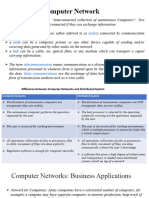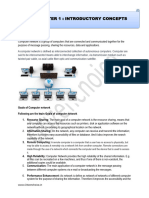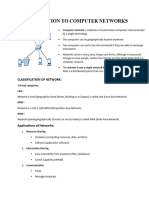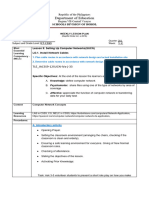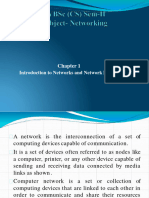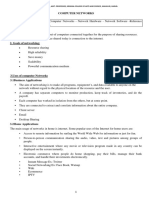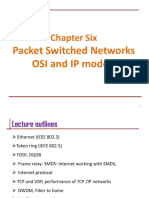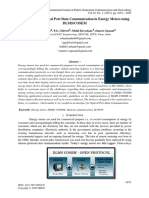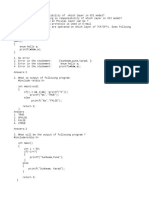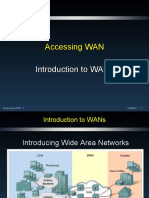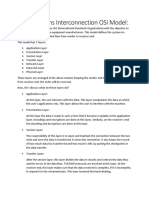CNFirst Chapter Notes
Uploaded by
Nikhath TaheraCNFirst Chapter Notes
Uploaded by
Nikhath Tahera-:Introduction:-
2 marks:-
1)what is network?
Computer network is a collection of two or more autonomous computer interconnected by a single
technology.
2)what is broadcasting? give an example?
Broadcasting network have a single communication channel that is shared by all the machine on the
network.
Ex:- A radio station broadcasts a signal to many listeners.
3) What is routing? Give example.
Routing is the process of moving packets across a network from one host to another It is performed
by devices called routers
Ex:-firewalls, switches.
4) What is LAN? Mention the uses.
Local Area Networks, generally called LAN’s are privately owned networks within a single, building
or campus up to few kilometers in size.
Uses of LAN:-sharing resources like files printer, games or other application.
5) Define protocol. Give an example.
A network protocol defines rules and conventions for communication between network devices.
6) Define OSI.
International standards organization (ISO) has developed a proposal as a first step towards
standardization of protocols used in different layers. This is called ISO-OSI
7) List any two home applications of computer network?
Access to remote information
Person-to-person communication
Interactive entertainment
Electronic commerce [E-commerce]
COMPUTER NETWORKS NAVEEN H Page 1
8) Define subnet?
The networks that result from dividing up a larger network are called subnets, which consist of router
and connecting lines.
9) Define Internet.
The Internet is the global system of interconnected computer networks that uses the Internet protocol
suite (TCP/IP) to communicate between networks and devices. It is a network of networks.
10) List the uses of internet for home uses.
Access to remote information
Person-to-person communication
Interactive entertainment
Electronic commerce
5 (or) 10 marks:-
1. Explain the uses of computer network.
Business application:-
Communication Medium among employees:-
Virtually every company that has two or more computers now has e-mail (electronic mail) , which
employees generally use for a great deal of daily communication . With a network, it is easy for two
or more people who work far apart to write a report together.
Videoconferencing:-
Using this technology, employees at distant locations can hold a meeting, seeing and hearing each
other and even writing on a shared virtual blackboard.
E-business with companies, suppliers and customers:-
Manufactures of automobiles, aircraft and computers, among orders electronically as others buy
subsystem from a variety of suppliers and then assemble the parts. Using computer networks
manufacturers can place order electronically as needed.
COMPUTER NETWORKS NAVEEN H Page 2
E-commerce
Airlines, bookstores, and music vendors have discovered that many customers like the convenience of
shopping from home. Consequently, many companies provide catalogs of their goods and services online and
task orders on-line. this sector is expected to grow quickly in the future it is called e-commerce
(electronic commerce).
Home Applications:-
Some of the more popular uses of the internet for home users are as follows:-
Access to remote information
Person-to-person communication
Interactive entertainment
Electronic commerce
Access to remote information:-
Surfing the World Wide Web for information or just for fun.
Many newspapers have gone on-line and can be personalized .For example; it is sometimes possible
to tell a newspaper that you want everything about corrupt politicians, big fires, scandals involving
celebrities.
On-line digital library:- many professional organization , such as the ACM and the IEEE computer
society , already have many journals and conference proceedings on-line.
Person-to-person communication:-
E-mail is already used on a daily basic by millions of people all over the world.
Instant messaging:- this facility , allows two people to type messages at each other in real time .
A multi- person version of this idea is the chat room in which a group of people can type messages
for all to see.
Worldwide newsgroups:-In this system one person posts a message and all the other
subscribers to the newsgroup can read it . Unlike chat rooms, newsgroups are not real time and
messages can be saved to read later.
Peer-to-peer communication:-to distinguish it from the client - server model. In this form,
individuals who form a loose group can communicate with others in the group, as shown in below
figure. every person can , in principle , communicate with one or more other people; there is no
fixed division into clients and servers.
COMPUTER NETWORKS NAVEEN H Page 3
Other communication-oriented applications include using the internet using the internet to carry
telephone calls, video phone, and internet radio.
Interactive entertainment
Video on demand
Game playing: already we have multi-person real –time simulation games, like hide-and-seek in
virtual dungeon, and flight simulators with the players on one team trying to shoot down the players
on the opposing team
Electronic commerce:
Home shopping is already popular and enables user to inspect the on-line catalogs of thousands of
companies.
Another area in which e-commerce is already happening is access to financial institution. Many
people already pay their bills, manage their bank accounts, and handle their investment
electronically.
Mobile users
Mobile computer ,such as notebook computers and person digital assistants are one of the fastest
growing segments of the computer industry .many owner of these computers have desktop machines
back at the office and want to be connected to their home base when away from home or en
route . Therefore, there is a lot of interest in wireless networks.
Example:- at computer conferences these days , the organizers often set up a wireless network in
the conference area . Anyone with a notebook computer and a wireless modem can just turn the
computer on and be connected to the internet .
In some of these cities , the taxis have a display the driver can see . When a customer calls up, a
central dispatcher types in the pickup and destination points.
This information is displayed on the drivers displays and a beep sound. The first driver to hit a button
on the display gets the call.
Wireless networks are also important to the military.
Here we see a distinction between fixed wireless and mobile
wireless.
COMPUTER NETWORKS NAVEEN H Page 4
Wireless Mobile Application
No no Desktop computers in offices
No Yes A notebook computer used in a
hotel form
2. What are the types of transmission technology? Explain?
There is no generally accepted taxonomy into which all computer networks fit, but
two dimensions are important, transmission technology and scale.
Broadly speaking, there are two types of transmission technology that are
in widely used. They are as follows;
1. Broadcast links
2. Point-to-point links
Broadcast networks have a single communication channel that is shared by
all the machines on the network. Short messages, called packets sent by any
machine are in turn received by all the others. An address field within the packet
specifies the intended recipient. Upon receiving a packet a machine checks the
address field. If the packet is intended for the receiving machine, that machine
processes the packet; if the packet is intended for some other, it is just ignored or
discarded.
As an analogy, consider a class room having many students and shouting
“Anil, stand up”. Although the message may actually be heard by all the students in
the class room, only Anil responds. The others just ignore it.
COMPUTER NETWORKS NAVEEN H Page 5
Broadcast systems also allow the possibility of addressing a packet to all
destinations by using a special code in the address field. When a packet with this
special code is transmitted, it is received and processed by every machine. This
mode of operation is called Broadcasting. Some broadcast systems also support
transmission to a group or subset of machines, known as multicasting.
In contrast, point-to-point networks consist of many connections between
individual pairs of machines. To send a message from the source to the destination,
a packet on this type of network may have to visit one or more intermediate
machines. Point-to-point transmission with one sender and one receiver is
sometimes called uncasing.
An alternative criterion for classifying networks is based on their size. The
following figure shows classification.
At the top are the personal area networks, networks that
are meant for one individual. For example, a wireless network connecting a
COMPUTER NETWORKS NAVEEN H Page 6
computer with its keyboard, mouse and printer is a personal area networks.
Beyond the personal area networks come longer- range network. These are local,
metropolitan, and wide area networks the connection of two or more networks is
called an internetwork.
COMPUTER NETWORKS NAVEEN H Page 7
3. Explain types of computer Network explain or Explain LAN,MAN,WAN.
Local Area Networks:-
Local Area Networks, generally called LANS, are privately – owned
networks within a single building or campus of up to few kilometers in size. A
LAN is useful for sharing resources like files, printers, games, or other
applications. An example of this would be a small office, with two or more
computers connected to the same printer. Another example would be a school,
where several computers are connected to shared resources (Plotters, faxes,
etc) and are then connected to the internet. LANs are distinguished from other
kinds of networks by three characteristics:
1) Their size, 2) their transmission technology, and 3) their topology
LANs are restricted in size, which means that worst–case transmission
time is bounded and known in advance.
LANs may use a transmission technology consisting of a cable to which
all the machines are attached. Traditionally LANS run at speeds of 10 Mbps to
100 Mbps, have low delay, and makes very few errors.
Various topologies are possible for broadcast LANs.
(a)
COMPUTER NETWORKS NAVEEN H Page 8
(b)
Two broadcast networks a) Bus b) Ring
In a bus network, one machine is the master and is allowed to transmit. All
other machines are required to hold back from sending. A mechanism is
required to resolve conflicts when two or more machines want to send
simultaneously. The mechanism may be centralized or distributed. IEEE 802.3
popularly called Ethernet is a bus based broadcast network with decentralized
control, operating at 10 Mbps to 10 Gbps. Computers on an Ethernet can
transmit whenever they want, if two or more packets collide each computer
waits a random amount of time and retransmits all over again later.
A second type of broadcast system is the ring. In a ring, each bit of a
packet propagates around on its own, without waiting for the rest of the packet
to which it belongs. Typically, each bit circulates the entire ring in the time it
takes to transmit a few bits, often before the complete packet has been
transmitted.
Metropolitan Area Networks:-
A Metropolitan Area Network generally called MAN, is a network that
interconnects users with computer resources in a geographical area or region
larger than that covered by a local area network (LAN). The term is applied to
the interconnection of networks in a city into a single larger networks.
A Man typically covers an area of between 5 and 50 km range. A Man is
not generally owned by a single organization. The MAN , its communications
links and equipments are generally owned by either a consortium of users or
by a network service provider who sells the service to the users.
A MAN (Metropolitan Area Network) covers a city. The best-known
examples of MANs are the cable television networks available in many cities.
These systems grew from earlier community antenna systems used in areas
with poor over-the-air television reception. In those early systems, a large
antenna was placed on top of a nearby hill and a signal was then piped to the
subscribers’ houses as sown in the following figure
COMPUTER NETWORKS NAVEEN H Page 9
Wide Area Networks
A wide area network (WAN):
• spans a large geographical area,
• contains hosts (or end-systems) intended for running user programs,
• the hosts are connected by a subnet that carries messages from host to host.
The subnet usually consists of transmission lines (circuits, channels, or trunks)
and switching elements. The switching elements are specialized computers used
to connect two or more transmission lines. These are known as routers.
If two routers that do not share a cable wish to communicate, they must do it via
other routers. When a packet is sent from one router to another via intermediate
routers, the packet is received at each intermediate router, stored there until the
required output line is free, and then forwarded. A subnet using this principle is
called point-to-point, store-and-forward, or packet-switched subnet. Nearly all
wide area networks (except those using satellites) have store-and-forward
subnets.
The following figure shows WAN network
COMPUTER NETWORKS NAVEEN H Page 10
4. Write a short note on wireless Networks.
Wireless Network is a network set up by using radio signal frequency to
Communicate among computers and other network devices. Some times it is
also referred to as wireless local area network (WLAN) or WIFI network. This
network is getting popular now a days due to easy to settle feature and no
cabling involved you can connect computers anywhere in your home without
the need of wires.
Wireless networks can be divided into three main categories:
1. System interconnection.
2. Wireless LANs.
3. Wireless WANs.
System interconnection is all about interconnecting the components of a
computer using short range radio. That is mouse, keyboard, printer etc are
connecting to a processor without wire.
Bluetooth technology is also allows connecting digital cameras, headsets,
scanners and other devices to a computer.
In the simplest form, system interconnection networks use the master-slave
paradigm shown in the following figure-a. The system unit is normally the
master, talking to the mouse, keyboard, etc., as slaves. The master tells the slaves
what addresses to use, when they can broadcast, how long they can transmit,
what frequencies they can use, and so on.
COMPUTER NETWORKS NAVEEN H Page 11
The next step up in wireless networking is the wireless LANs. These are systems
in which every computer has a radio modem and antenna with which it can
communicate
unicate with other systems shown in the figure
figure-b.
5. Explain briefly gateways.
Many networks exist in the world, often with different hardware and software.
People connected to one network often want to communicate with people
attached to a different one. The fulfillment of this desire requires that different,
and frequently incompatible networks, be connected, sometimes by means of
machines called gateways to make the connection and provide the necessary
translation, both in terms of hardware and software
software.
6. Explain protocolhierarchies.
To reduce the design complexity, most networks are
organized as a stack of layers. The number of layers, the name of each layers
the contents of each layer, and the function of each layer differs from network
to network. The purpose of each layer is to offer certain services to the higher
layers.
Layer n on one machine carries a conversation with layer n on another
machine. The rules and conventions used in this conversation are known as the
layer n protocol. A protocol
otocol is an agreement between the communicating
COMPUTER NETWORKS NAVEEN H Page 12
parties on how communication is to proceed.
The five layer network is demonstrated in the following figure.
The entities comprising the corresponding layers on different machines are
called peers. The peers may be processes hardware, or even human beings.
In reality, no data are directly transmitted from layer n on one machine
to layer n on another machine. Instead, each layer passes data and control
information to the layer immediately below it, until it reaches the lower layer.
Below layer is the physical medium through which actual communication
occurs. In the Figure,virtual communication is shown by dotted lines and
physical communication by solid lines.
Between each pair of adjacent layers, is an interface. The interface
defines which primitive operations and services the lower layer makes
available to the upper one.
A set of layers and protocols is called network architecture. A list of
protocols used by a certain system ,one protocol per layer is called a protocol
stack.
Now consider a more technical example; as illustrated in Fig.
COMPUTER NETWORKS NAVEEN H Page 13
A message, M is produced by an application running in layer 5 and
given to layer 4 for transmission. Layer 4 puts a header in front of the message
and passes the result to layer 3. The header includes control information such
sequence numbers to allow layers 4 on the destination machine to deliver
messages in the right order.
In many networks, there is no limit to the size of messages transmitted in
the layer 4 protocol, but there is nearly a limit imposed by the layer 3
protocol consequently, layer 3 break up the message into smaller units, packets
. Prepending a layer 3 header to each packet. In this example, M is split into
two parts , M1 and M2.
Layer 3 decides which of the outgoing lines to use and passes the
packets to layer 2. Layer 2 adds not only a header, but also a trailer, and gives
the resulting unit to layer1. At the receiving machine the message moves
upward, from layer to layer, with headers being stripped off as it progresses.
7. Explain design issues for the layers
Some of the designing issues that occur in computer networks are present
in several layers. Below, we will mention some of the important issues.
i) Addressing
Each layer needs a mechanism for identifying senders and receivers.
Since a network has many computers, a means is needed for a process on one
machine to specify with whom it wants to communicate. Some form of
addressing is needed in order to specify a specific destination.
ii) Data Transfer
In some systems, data only travel in one direction; in others, data can go
both ways. Many networks have at least two channels per connection one for
normal data and one for urgent data.
iii) Error Control
COMPUTER NETWORKS NAVEEN H Page 14
It is an important issue because communication circuits are not perfect.
There are many error-correcting mechanisms, but both ends must agree on
which one is being used. Further, the receiver must have some way of telling
the sender which messages have been correctly received and which has not.
iv) Flow control
An issue that occurs at every level is how to keep a fast sender from
overtaking a slow receiver with data. Various solutions have been proposed.
Some of them involve some kind of feedback from the receiver to the sender.
Others limit the sender to an agreed-on transmission rate. This is called flow
control.
v) Routing
When there are multiple paths between source and destination a
minimal or optimal route must be chosen. This is called Routing.
vi) Multiplexing and demultiplexing
it is inconvenient or expensive to set up a separate connection for each
pair of communicating processes, so the underlying layer may decide to use
the same connection for passing multiple signals this technique is known as
multiplexing and the reverse process is known as demultiplexing.
8. Explain connection oriented and connectionless services.
Layers can offer two different types of service to the layers above
them connection – oriented and connectionless.
Connection–oriented service is modeled after the telephone system. To
talk to someone you pick up the phone, dial the number, talk, and then hang
up. Similarly, to use a connection oriented network, the user first establishes
the connection, uses it, and then releases the connection.
The sender and receiver negotiates about parameters to be used. Such as
packet size, quality of service, and other issues. Typically, one side makes a
proposal and the other side can accept it, reject it, or make a counter proposal.
COMPUTER NETWORKS NAVEEN H Page 15
In contrast, connectionless service is modeled after postal system. Each
message carries the full destination address, and each one is sent
independently. Normally, when two messages are sent to the same destination.
The first one sent can be delayed so that second one arrives first.
In this service, there is a chance of data loss, and packet sequencing is
necessary at the destination because packets travel independently.
A service is a set of primitives or operations that a layer provides to the
layer above it. The service defines what operations the layer is prepared to
perform on behalf of its users, but it says nothing about how these operations
are implemented.
A protocol, in contrast, is a set of rules governing the format and
meaning of the packets, or messages that are exchanged by the peer entities
within a layer. Entities use protocols to implement their service.
In other words, services relate to the interfaces between layers.
In contrast, protocols relate to the packets sent between peer entities on
different machines.
The following table shows six different types of services
Reliable connection-oriented service has two minor variations: message
stream and byte streams. In the message stream, the message boundaries are
preserved. For example When two 1024-byte messages are sent, they arrive as
two distinct 1024-byte messages, never as one 2048-byte message.
COMPUTER NETWORKS NAVEEN H Page 16
In the byte stream , the connection is simply a stream of bytes, with no
message boundaries. When 2048 bytes arrive at the receiver, there is no way to
tell if they were sent as one 2048-byte message, two 1024-byte messages, or
2048 1-byte messages.
unreliable connection usually used for digitized voice and
videoconferencing. In those applications small amount of errors are allowed.
Unreliable datagram does not require connections. For example, as
electronic mail becomes more common.
In other situations, the convenience of not having to establish a
connection to send one short message is desired, but reliability is essential.
The acknowledged datagram service can be provided for these applications. It
is like sending a registered letter and requesting a return receipt.
Still another service is the request-reply service. In this service the
sender transmits a single datagram containing a request; the reply contains
the answer.
9. Explain service primitives.
A service is formally specified by a set of primitives (operations)
available to a user process to access all service. These primitives tell the
service to perform some action or report on an action taken by a peer entity.
The set of primitives available depends on the nature of the service
being provided. The primitives for connection-oriented service are different
from those of connectionless service. As a minimal example of implementing a
reliable byte stream in a client-server environment consider the primitives
listed in the below table.
Primitive Meaning
COMPUTER NETWORKS NAVEEN H Page 17
LISTEN Block waiting for an incoming connection
CONNECT Establish a connection with a waiting peer
RECEIVE Block waiting for an incoming message
SEND Send a message to the peer
DISCONNECT Terminate a connection
Five service primitives for implementing a simple connection- oriented service
First, the server executes LISTEN to indicate that it is prepared to
accept incoming connections . After executing the primitive , the server
process is blocked until a request for connection appears.
Next , the client process executes CONNECT to establish a connection
with the server . The CONNECT call needs to specify who to
connect to so it might have a parameter giving the server’s
address . the operating system then typically sends a packet to the
peer asking it to connect, as shown .the client process is suspended
until there is a response.
When the packet arrives at the server, it is processed by the operating
system there . When the system sees that the packet is requesting a
connection .it checks to see if there is a listener. If so, it does two
things: unblock the listener and sends back an acknowledgment(2) .
the arrival of this acknowledgement then releases the client . At this
COMPUTER NETWORKS NAVEEN H Page 18
point the client and server are both running and they have a
connection established.
Packets sent in a simple client-server interaction on a connection-oriented
network
The next step is for the server to execute RECEIVE to prepare to
accept the first request . Normally , the server does this
immediately . upon being released from the LISTEN , before the
acknowledgement can get back to the client . The RECEIVE call blocks
the server.
Then the client executes SEND to transmit its request (3) followed by
the execution of RECEIVE to get the reply.
The arrival of the request packet at the server machine unblocks the
sever process so it can process the request . After it has done the
work, it uses SEND to returns the answer to the client(4).
The arrival of this packet unblocks the client , which can inspect the
answer. If the client has additional requests, it can make them now . if it
is done , it can use DISCONNECT to terminate the connection. Usually ,
an initial DISCONNECT is a blocking call , suspending the client and
sending a packet to the server saying that the connection is no
longer needed(5).
When the server gets the packet , it also issues a DISCONNECT of
its own , acknowledging the client and releasing the connection .
When the server’s packet gets back to the client machine, the client
process is released and the connection is broken.
9. Explain relationship between services to protocols.
A service is a set of primitives (operations) that a layer provides to the
layer above it. The service defines what operations the layer is prepared to
perform on behalf of its users, but it says nothing at all about how these
operations are implemented. A service relates to an interface between two
layers, with the lower layer being the service provider and the upper layer
being the service user.
COMPUTER NETWORKS NAVEEN H Page 19
A protocol, in contrast, is a set of rules governing the format and
meaning of the packets, or messages that are exchanged by the peer entities
within a layer. Entities use protocols to implement their service definitions.
They are free to change their protocols at will, provided they do not change the
service visible to their users. In this way, the service and the protocol are
completely decoupled. In other words, services relate to the interfaces between
layers, as illustrated in the following figure. In contrast, protocols relate to the
packets sent between peer entities on different machines.
Relationship of services to protocols.
10. Explain OSI reference model in detail.
It was first introduced in the late 1970s. An open system is a set of protocols that allows any two
different systems to communicate regardless of their underlying architecture. The purpose of the
OSI model is to show how to facilitate communication between different systems without
requiring changes to the logic of the underlying hardware and software.
COMPUTER NETWORKS NAVEEN H Page 20
Layered Architecture
The OSI model is composed ofseven ordered layers: physical (layer 1), data link (layer 2),
network (layer 3), transport (layer 4), session (layer 5), presentation (layer 6), and application
(layer 7). Figure shows the layers involved when a message is sent from device A to device B.
The processes on each machine that communicate at a given layer are called peer-to-peer
processes
Interfaces Between Layers
Each interface defines the information and services a layer must provide for the layer above it.
Organization of the Layers
The seven layers can be thought of as belonging to three subgroups. Layers I, 2, and 3-physical,
data link, and network-are the network support layers; they deal with the physical aspects of
moving data from one device to another (such as electrical specifications, physical connections,
physical addressing, and transport timing and reliability). Layers 5, 6, and 7-session, presentation,
and application-can be thought of as the user support layers; they allow interoperability among
unrelated software systems. Layer 4, the transport layer, links the two subgroups
COMPUTER NETWORKS NAVEEN H Page 21
At each layer, a header, or possibly a trailer, can be added to the data unit.
Physical Layer
The physical layer coordinates the functions required to carry a bit stream over a physical
medium.
The physical layer is also concerned with the following:
Physical characteristics of interfaces and medium.:- The physical layer defines the characteristics
of the interface between the devices and the transmission medium. It also defines the type of
transmission medium.
Representation of bits.:- for a data transmission bits must be encoded into signals--electrical or
optical. The physical layer defines the type of encoding (how O(zero) and I(one ) are changed to
signals).
Data rate. The transmission rate-the number of bits sent each second-is also defined by the
physical layer.
Synchronization of bits. The sender and receiver not only must use the same bit rate but also must
be synchronized at the bit level. In other words, the sender and the receiver clocks must be
synchronized.
Line configuration. The physical layer is concerned with the type of connection between
devices. Ie point-to-point or multipoint
Physical topology. The physical topology defines type of topology the network uses
iemesh,star,bus or ring
Transmission mode. The physical layer also defines the direction of transmission between two
devices: simplex, half-duplex, or full-duplex.
Data Link Layer
The data link layer transforms the physical layer, a raw transmission facility, to a reliable link.
Other responsibilities ofthe data link layer include the following:
Framing. The data link layer divides the stream of bits received from the network layer into
manageable data units called frames.
Physical addressing. If frames are to be distributed to different systems on the network, the data
link layer adds a header to the frame to define the sender and/or receiver of the frame.
Flow control. If the rate at which the data are absorbed by the receiver is less than the rate at
which data are produced in the sender, the data link layer imposes a flow control mechanism to
avoid data loss.
COMPUTER NETWORKS NAVEEN H Page 22
Error control. The data link layer adds reliability to the physical layer by adding mechanisms to
detect and retransmit damaged or lost frames. It also uses a mechanism to recognize duplicate
frames. Error control is normally achieved through a trailer added to the end of the frame.
Access control. When two or more devices are connected to the same link, data link layer
protocols are necessary to determine which device has control over the link at any given time.
Network Layer
The network layer is responsible for the source-to-destination delivery of a packet, possibly
across multiple networks (links). Whereas the data link layer oversees the delivery of the packet
between two systems on the same network (links), the network layer ensures that each packet gets
from its point of origin to its final destination.
Other responsibilities ofthe network layer include the following:
Logical addressing. The physical addressing implemented by the data link layer handles the
addressing problem locally. If a packet passes the network boundary, we need another addressing
system to help distinguish the source and destination systems. The network layer adds a header to
the packet coming from the upper layer that, among other things, includes the logical addresses of
the sender and receiver.
Routing. This layer provide route to all packets travelling through the network this routing
mechanism is based on the routing algorithms which are running in router.
Transport Layer
The transport layer is responsible for process-to-process delivery of the entire message.
Other responsibilities ofthe transport layer include the following:
Service-point addressing:- Computers often run several programs at the same time. For this
reason, source-to-destination delivery means delivery not only from one computer to the next but
also from a specific process (running program) on one computer to a specific process (running
program) on the other.
the transport layer gets the entire message to the correct process on that computer.
Segmentation and reassembly:- A message is divided into transmittable segments, with each
segment containing a sequence number. These numbers enable the transport layer to reassemble
the message correctly upon arriving at the destination and to identify and replace packets that
were lost in transmission.
Connection control:- The transport layer can be either connectionless or connection oriented. A
connectionless transport layer treats each segment as an independent packet and delivers it to the
transport layer at the destination machine. A connection oriented transport layer makes a
connection with the transport layer at the destination machine first before delivering the packets.
After all the data are transferred, the connection is terminated.
COMPUTER NETWORKS NAVEEN H Page 23
Flow control: - Like the data link layer, the transport layer is responsible for flow control.
However, flow control at this layer is performed end to end rather than across a single link.
Error control: - Like the data link layer, the transport layer is responsible for error control.
However, error control at this layer is performed process-to process rather than across a single
link.
Session Layer
The session layer is the network dialog controller. It establishes, maintains, and synchronizes the
interaction among communicating systems.
Specific responsibilities of the session layer include the following:
Dialog control. The session layer allows two systems to enter into a dialog. It allows the
communication between two processes to take place in either half duplex (one way at a time) or
full-duplex (two ways at a time) mode.
Synchronization. The session layer allows a process to add checkpoints, or synchronization
points, to a stream of data. For example, ifa system is sending a file of2000 pages, it is advisable
to insert checkpoints after every 100 pages to ensure that each 100-page unit is received and
acknowledged independently. In this case, if a crash happens during the transmission of page 523,
the only pages that need to be resent after system recovery are pages 501 to 523. Pages previous
to 501 need not be resent because those already acknowledged.
Presentation Layer
The presentation layer is concerned with the syntax and semantics of the information exchanged
between two systems.
Specific responsibilities of the presentation layer include the following
Translation.
The presentation layer at the sender changes the information from its sender-dependent format
into a common format. The presentation layer at the receiving machine changes the common
format into its receiver-dependent format.
Encryption.
To carry sensitive information, a system must be able to ensure privacy. Encryption means that
the sender transforms the original information to another form and sends the resulting message
over the network. Decryption reverses encryption process in order to get original data.
Compression.
Data compression reduces the number of bits contained in the information. Data compression
becomes particularly important in the transmission of multimedia such as text, audio, and video.
COMPUTER NETWORKS NAVEEN H Page 24
Application Layer
The application layer enables the user, whether human or software, to access the network. It
provides user interfaces and support for services such as electronic mail, remote file access and
transfer, shared database management, and other types of distributed information services
Specific services provided by the application layer include the following:
Network virtual terminal: - A network virtual terminal is a software version of a physical
terminal, and it allows a user to log on to a remote host.
File transfer, access, and management.
This application allows a user to access files in a remote host (to make changes or read data), to
retrieve files from a remote computer for use in the local computer, and to manage or control files
in a remote computer locally.
Mail services
This application provides the basis for e-mail forwarding and storage.
11. Explain TCP/IP reference model.
The above diagram shows comparison between OSI and TCP/IP reference model.
This model consists of 5 layers as shown in shown
Physical and Data Link Layers
Network Layer
COMPUTER NETWORKS NAVEEN H Page 25
At the network layer (or, more accurately, the internetwork layer), TCP/IP supports the
Internetworking Protocol(IP). IP, in turn, uses four supporting protocols: ARP, RARP, ICMP,
and IGMP.
Internetworking Protocol (IP)
The Internetworking Protocol (IP) is the transmission mechanism used by the TCP/IP protocols.
Itis an unreliable and connectionless protocol service.
IP transports data in packets called datagrams, each of which is transported separately. These
Datagrams can travel along different routes to reach a destination machine.
Address Resolution Protocol
The Address Resolution Protocol (ARP) is used to associate a logical address with a physical
address.
Reverse Address Resolution Protocol
The Reverse Address Resolution Protocol (RARP) allows a host to discover its Internet address
when it knows only its physical address.
Internet Control Message Protocol
The Internet Control Message Protocol (ICMP) is a mechanism used by hosts and gateways to
send notification of datagram problems back to the sender.
Internet Group Message Protocol
The Internet Group Message Protocol (IGMP) is used to facilitate the simultaneous transmission
of a message to a group of recipients
Transport Layer
This layer supports three protocols ie UDP, TCP and SCTP as explained below.
User Datagram Protocol(UDP)
This protocol provides connectionless oriented service. Here transport layer adds a port address
for each segment.
Transmission Control Protocol(TCP)
The Transmission Control Protocol (TCP) provides full transport-layer services to applications.
TCP provides connection oriented service ie A connection must be established between both ends
of a transmission before data sending a data.
At the sending end of each transmission, TCP divides a stream of data into smaller units called
segments. Each segment includes a sequence number for reordering after reaching at destination
COMPUTER NETWORKS NAVEEN H Page 26
side together with an acknowledgment number for the segments received. Segments are carried
across the internet inside of IP datagrams.
Stream Control Transmission Protocol
The Stream Control Transmission Protocol (SCTP) provides support for newer applications such
as voice over the Internet.
Application Layer
The application layer in TCPIIP is equivalent to the combined session, presentation, and
application layers in the OSI model Many protocols are defined at this layer. Few of them are
explained as below.
Simple mail transmission protocol(SMTP):-it provides mail servicing fecility.
File transmission protocol(FTP):-it provides file transmission facility across a network.
Application Layer
This layer responsible for providing user interface to use a network, in order to provide this
facility TCP/IP model support many protocols among are
Simple Mail Transfer Protocol(SMTP):-it is a TCP/IP protocol used in sending and receiving e-
mail.
File Transfer Protocol (FTP) is the commonly used protocol for exchanging files over
the Internet. FTP uses the Internet's TCP/IP protocols to enable data transfer
HTTP :-it means means HyperText Transfer Protocol. HTTP is the underlying protocol used by
the World Wide Web and this protocol defines how messages are formatted and transmitted, and
what actions Web servers and browsers should take in response to various commands.
Domain Name System (or Service or Server):- it is an Internet service that translates domain
names into IP addresses
Simple Network Management Protocol (SNMP):- it is an Internet Standard protocol for
collecting and organizing information about managed devices on IP networks and for modifying
that information to change device behavior
Telnet:- it is a user command and an underlying TCP/IP protocol for accessing remote
computers. Through Telnet, an administrator or another user can access someone else's computer
remotely
COMPUTER NETWORKS NAVEEN H Page 27
12. Compare the OSI and TCP/IP reference model.
OSI TCP/IP reference model
It stands for Open System It stands for Transmission Control
Interconnection. Protocol.
It is an independent standard and It consists of standard protocols that
generic protocol used as a lead to the development of an internet.
communication gateway between the It is a communication protocol that
network and the end user. provides the connection among the
hosts.
OSI model has been developed by ISO It was developed by ARPANET
(International Standard Organization). (Advanced Research Project Agency
Network).
In the OSI model, the transport layer The transport layer does not provide
provides a guarantee for the delivery of the surety for the delivery of packets.
the packets. But still, we can say that it is a reliable
model.
In this model, the session and In this model, the session and
presentation layers are separated, i.e., presentation layer are not different
both the layers are different. layers. Both layers are included in the
application layer.
It is also known as a reference model It is an implemented model of an OSI
through which various networks are model
built. For example, the TCP/IP model
is built from the OSI model. It is also
referred to as a guidance tool.
In this model, the network layer The network layer provides only
provides both connection-oriented and connectionless service.
connectionless service.
Protocols in the OSI model are hidden In this model, the protocol cannot be
and can be easily replaced when the easily replaced.
technology changes.
It consists of 7 layers. It consists of 4 layers.
OSI model defines the services, In the TCP/IP model, services,
protocols, and interfaces as well as protocols, and interfaces are not
provides a proper distinction between properly separated. It is protocol
them. It is protocol independent. dependent.
The usage of this model is very low. This model is highly used
COMPUTER NETWORKS NAVEEN H Page 28
13. write a critique of the OSI model and protocol in brief.
Neither the OSI model and its protocols nor the TCP/IP model and its protocol are perfect . they
can be summarized as:
Bad timing
Bad technology
Bad implementation
Bad politics
Bad timing:-
The time at which a standard is established is absolutely critical to its success. When the subject is first
discovered, there is a burst of research activity in the form of discussions, papers, and meetings.
Bad technology:-
The second reason that OSI never caught on is that both the model and the protocols are flawed. The
choice of seven layers was more political than technical, and two of the layer is nearly empty, whereas
two other ones are overfull.
Bad implementation:-
Given the enormous complexity of the model and the protocols, it will come as no surprise that the
initial implementation were huge, unwieldy, and slow.
Bad politics:-
On the account of the initial implementation , many people , especially in academia , though of TCP/IP
as part of UNIX , and UNIX in the 1980s in academia was not unlike parenthood and apple pie.
COMPUTER NETWORKS NAVEEN H Page 29
You might also like
- BA - Unit 4. Computer Network FundamentalsNo ratings yetBA - Unit 4. Computer Network Fundamentals31 pages
- 4.2 Computer Network & Data CommunicationNo ratings yet4.2 Computer Network & Data Communication26 pages
- CNS - Unit 1 (Introduction To Computer Networks) - NotesNo ratings yetCNS - Unit 1 (Introduction To Computer Networks) - Notes69 pages
- Computer Networks: Dr. Abbas AbdulazeezNo ratings yetComputer Networks: Dr. Abbas Abdulazeez22 pages
- Week # 03 Introduction To Computer Networks 1) Computer NetworksNo ratings yetWeek # 03 Introduction To Computer Networks 1) Computer Networks11 pages
- Computer Network & Data Communication f3No ratings yetComputer Network & Data Communication f316 pages
- Prototype Lesson Plan in Css9-2nd QuarterNo ratings yetPrototype Lesson Plan in Css9-2nd Quarter21 pages
- 548 16sccca8-16scccs6-16sccit6 2020051603545429No ratings yet548 16sccca8-16scccs6-16sccit6 202005160354542916 pages
- IJRECE performanceanalysisofAODV PublishedNo ratings yetIJRECE performanceanalysisofAODV Published6 pages
- Government Data Center Reference ArchitectureNo ratings yetGovernment Data Center Reference Architecture29 pages
- Protocol Specification For Interfacing To Data Communication NetworksNo ratings yetProtocol Specification For Interfacing To Data Communication Networks205 pages
- Data Communication and Computer Network: - 9.1 IntroductionNo ratings yetData Communication and Computer Network: - 9.1 Introduction77 pages
- Data Communication and Computer Network Assignment PDFNo ratings yetData Communication and Computer Network Assignment PDF5 pages
- CS31K Data Communications & Computer NetworksNo ratings yetCS31K Data Communications & Computer Networks41 pages
- Centaur XP Interface Specification ManualNo ratings yetCentaur XP Interface Specification Manual292 pages
- Designing Embedded Communications SoftwareNo ratings yetDesigning Embedded Communications Software239 pages
- OSI Model 7 Layers Explained in Computer NetworkNo ratings yetOSI Model 7 Layers Explained in Computer Network8 pages









